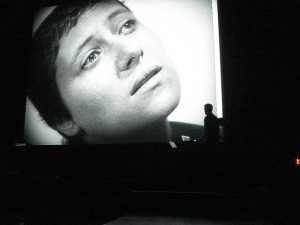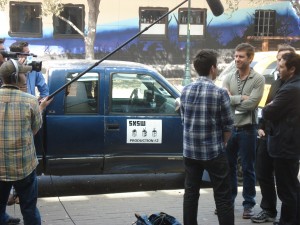Archive for the ‘Film’ Category
|SXSW Journal 2010
March 22nd, 2010
I get sentimental about SXSW. It’s the only place/experience I can think of that seamlessly blends two of my passions: tech entrepreneurship and film. There’s music of course. But it’s almost too much to bring that into the conversation – an embarrassment of riches.
There’s a pleasurable cognitive dissonance in attending both the Interactive and Film festivals. One minute you’re delving into the details of a new twitter app, try or debating health insurance reform (SXSW has a whole healthcare component now called SXSH – South by South Health) and the next, physician totally losing it at an interview with Michel Gondry, because you can’t believe he’s just standing there 3 feet in front of you, wearing a plaid shirt like every other dude in Austin and talking about his process. Then you go outside into the beautiful sunlight, and you think I’m in *&(*ing TEXAS. You see cowboy hats and pick-up trucks and places to eat BBQ, and then you run into a friend and grab a beer and you talk shop and suddenly you’re making a business deal. And then it’s right back to a session on how hospitals are using social media followed by a panel on how cinema can be saved in the digital era followed by a film screening/Q&A with an inspiring director who worked on his labor of love for 5 years and finished editing two days ago.
And so it went for 6 amazing days. 14 hours a day. Here were some of the great moments:
Michel Gondry’s “The Thorn in the Heart”
A slow, subtle documentary about Michel Gondry’s elderly Aunt Suzette, who taught in schools around France over 50-60 years. The film follows her as she visits the sites of her former schools and provides commentary as she remembers different eras, communities and students. “Why would I be interested?” you think. One: it’s Michel Gondry, something really amazing is going to happen. So indeed, along the way, we’re introduced to her son, Jean Yves. And it is the story of the relationship between Suzette and her son (now in his 50s) that emerges slowly and becomes the gripping, poignant and unforgettable center of the film. Complete with actual Super-8 footage from home videos this is a treat of a documentary – Gondry in Q&A after said that he used to think hanging out with Bjork and her friends meant he was finally surrounded by interesting people, when he rediscovered that the people in his own family were as, if not more, interesting.
Steven Soderbergh’s “And Everything is Going Fine”
I left the film with that blissful, wordless feeling. The feeling when you can’t talk for a while after you leave the theater because you’re overwhelmed and overflowing and so impressed and so in it still. Spalding Gray is fascinating to watch as a performance artist. If the film were just cobbled together footage of his monologues, it would have been completely satisfying. But through Soderbergh’s directing and Susan Littenberg’s editing virtuosity, we are lead through the story of Gray’s life chronologically by major life event BUT via monologues and interviews from any point in his life when he’s referring to that particular incident. What you get is a mosaic of a journey, semi linear, semi circular where the themes of Gray’s childhood, his mother’s suicide, his sexuality, adultery, fatherhood, death all blend into and yet lead off from each other.
The film does not go into the manner of Spalding Gray’s death, which is an artful act of restraint. It’s left for people to discover for themselves. We begin with the impact of his mother’s suicide on him as a young person, and end with a fragile older man, crippled by a devastating car accident and we sense that in some way, he’s ready to be reunited with her.
Paul Gordon’s “The Happy Poet”
Man, I loved this indie gem of a movie about a poet, saddled with student loans after finishing a Masters in Creative Writing, who decides to open an organic food stand (named The Happy Poet) to make ends meet. Everyone wonders why he doesn’t just do the high margin hot dog stand thing, but he has principles. Principles but no cash. And we go through the journey of a true start-up in the making, his attempts at branding, marketing, managing costs, and how he handles an offer by a VC to scale the business. The semi-slimy money guy says: “The reason people steal your ideas is you don’t believe in them enough yourself. Do you believe in the Happy Poet? Will you put your money where your mouth is?” And that marks a turning point in the trajectory of this one little dream. And since making an independent film is like doing a start-up no one believes in at first, the unspoken reference made me smile.
Jason Spingarn-Koff’s “Life 2.0″
I was skeptical I’d learn anything new from a documentary about virtual worlds and Second Life. After all, I think I understand something about social media and how lives are being impacted by it, especially in the realm of health. Forget about it. I know nothing. Or at least I’ve significantly underestimated the impact.
We’re introduced to 3 characters whose lives are or at one time were so intertwined with their avatar selves that there was no real distinction between the virtual world and the real world. It goes beyond aspirational issues – yes, many people who are obese in real life have skinny avatars. But who knew it could help people deal with childhood trauma, become their chief economic activity, as in generate a 6-figure income in real US dollars, lead to the first lawsuit of avatars suing avatars, dissolve marriages and rebuild denied memories. This was not a freak show. It was a face of human reality as could have only been exposed by virtual reality.
Carl Theodore Dreyer’s “The Passion of Joan of Arc”
I kept being floored, every minute, every frame. This was made in 1928. What? The film actually disappeared for many years and was presumed lost in a fire, until it turned up in 1981 in the closet of a mental asylum in Norway. It was lovingly restored in 1985.
It is visually stunning, amazingly paced, the camera angles are innovative and not lazy, the color of the black and white is beautiful, the cast, even minor characters were chosen with great care, the impact of the closeups of peoples faces is a function of great acting and great directing and great cinematography, but mainly I admired the commitment to a difficult emotional tone that was held and controlled with great precision by the director. Wow. 1928. We’ve since unlearned so much about what makes a movie a great movie.
The score was performed live on stage by punk band In the Nursery. Oh god. This was definitely an “I’ve died and gone to heaven” cinematic experience. In the picture below you see the musicians on stage in front of the screen. They used synthesizers, laptops and an instrument that looked like a recorder.
A little bit of Music
The highlight of the Music Festival was clearly Baron von Luxxury’s performance at Max’s Wine Dive. What else did I need to see after that?!
Indu Subaiya’s “Austin”
This little monologue on film wouldn’t be complete if I didn’t say something ‘DVD extra-like’: the city of Austin was like a character itself in the film of being at SXSW ![]() Here are some behind the scenes shots.
Here are some behind the scenes shots.
A film about the fans instead of the band
January 31st, 2010
The Posters Came from the Walls is probably the best depiction of ‘fanhood’ on film I’ve ever seen. There is little to no footage of the actual members of Depeche Mode – other than a few clips of bootlegged video. Instead, grip it surveys a bewildering range of Depeche Mode devotees from Tehran, to Romania, Los Angeles, London & St. Petersburg. People who treat the lyrics as transcendental poetry, one man who was homeless for 5 years listening to the 101 album on tape on his little box everyday till going to a DM concert got him back into society, others for whom it represented freedom from the iron wall, a fervent few who worship in goth churches where the songs are listened to as hymns. I HAD NO IDEA.
Who wasn’t a Depeche Mode fan in 1987? At least if you were remotely into cultivating an intellectual/individualist brand for your highschool outcast self. But the fact there are teenagers in Pasadena today who worship, as in actually light incense everyday, in front of a Depeche Mode poster, that’s some kind of testimony to the music. The filmmakers were in the house at Cinefamily @ The Silent Movie Theater where it screened last night and succeeded in presenting these fans as moving, 3 dimensional people and not as freaks on parade (although the family that dresses up in robes every weekend and films themselves to DM music came close). The name “The Posters Came from the Walls” is from a description an East German fan gives to seeing a DM concert for the first time after the Wall fell – he said, before that, living in a totalitarian state, you never expected to have the chance of seeing your heroes in real life, but going to that concert was a radical experience – it was the first time his posters came alive.
What lies beyond the cringe
October 17th, 2009
Last night I met a different kind of hero. A hero for our times. Not in spandex and a cape, diabetes and pregnancy but in small but strangely loose (for how small they were) gym shorts and alternating head bands. Adventures of Power is about Power, the son of a copper miner, whose harshest word is “shoot” and whose passion is to feel the music to the point of moving inexplicably to play ‘air drums’ because his father couldn’t afford to give him an actual drum-set or drumming lessons. But this seeming deficiency turns into the hero’s greatest strength as he exhaustedly realizes after overcoming many a difficulty to get to the air drumming championships in Newark, NJ, that he doesn’t need drums, he is drums.
While full of comfortably referential moments for a generation that’s grown up on a diet of mockumentaries and fish out of water dramedies, what gilds this strange child in a layer of specialness is its song of protest and its complete surrender to what must be one of the higher states of Buddhist spirituality – a total lack of self consciousness. As we watch Power clear out rooms with his gyrations, we are taken to the point of cringing and then menacingly further till we realize that what lies beyond the cringe, if we would ever be brave enough to get there ourselves, is an innocence and freedom so pure it’s exhilarating, and we are not just relieved, we’re made proud.
Ari Gold shows us independent filmmaking at its uncompromising, auteurist best. Four years in the making, on a budget orders of magnitude less than its authentic locations and large ensemble cast would lead you to believe, each seamlessly edited moment is rich with design details and a musical texture so integrated with the story that it could have only been created along with the process, not laid down after. Songwriter, performer, producer Ethan Gold displays an astonishing intuition, stamina and range of genre talent as the soundtrack majestically becomes the spine of the film.
And so Power, with a vibrant visual and sonic landscape at his back makes his way through his adventure – to express solidarity with his father and fellow strikers at the copper mine back home and to find a place in a world where no one understands ‘no drums’.
There are several reasons why he is a hero. It would be one thing if he took us on the staple arc of ugly duckling discovering he’s a swan, or misfit triumphing over the cool kids. But Power’s insistent message is ‘we’re not better, we’re different’ and his only request of his opponent is not to be less evil, or to give up and go home, but to fight as if he means it, to take the challenge seriously. Ari Gold uses a flippant vehicle to deliver a slap in the face about being honest, about knowing when and whom to laugh at. He’s a new kind of hero because his $2,000 prize money won’t go towards a new apartment – he currently sleeps in a tent when his aunt needs to rent out his room for extra money – or to win the girl, all she wants is his soul and a bit of organic “o” cereal – and it certainly won’t go towards buying an expensive drum set. It goes half to his musical idol and half to the copper miners who’ve lost paychecks because of the strike.
The punctuated violence of the riot police is contrasted by the constancy of the miners’ passive resistance, and our own ability to tap into an eternal beat originating from our mothers’ wombs and carrying us forward, invisible, reassuring, highly idiosyncratic, yet when combined in the right moments with the beat that others dance to, supremely Powerful.
SXSW Day 2
March 16th, 2009
Holy crazy overachieving feature directorial debut alert! Sin Nombre was jawdroppingly good. Cary Fukunaga, eczema 31, cure of Oakland…don’t ever let me underestimate filmmakers from the Bay Area! He researched Central American gangs for two years, buy sat in prison cells with them as they copyedited his script (which was in Spanish, even though he’s not a native speaker), then rode on TOP of immigrant trains from Honduras to Mexico to prepare for this moving, beautifully filmed, border crossing saga. No surprise, it will be released in theaters (NY, LA and SF) on March 20th.
SXSW Day 1
March 15th, 2009
From the balcony level at the majestic Paramount theater in Austin, pilule I started the festival with Alexander the Last, nurse Joe Swanberg’s 5th film in 5 years to premiere at SXSW. Does this man sleep? In a first in terms of distribution platform, vitamin it was simultaneously available on demand to cable viewers. Handheld, intimate shots of couples in relationships, being tempted by people they worked with in creative collaborations; lots of talking, staring, thinking, making out. It was sexy and real.
Walking down 6th Street.
A short I made in NY
November 17th, 2007
So this little dab of noir was created this past summer during a directing class I took at the School of Visual Arts in NYC. We were given just a few days to write a script with the following constraints: no more than 2 pages, cardiologist which translates to about 2 minutes of viewing time, pilule 2-3 characters max, abortion and it had to take place in a bar. I was watching and reading a lot of David Mamet and so I was obsessed with manipulation and backstabbing and hatched this little triple betrayal vignette. It was an incredible thrill to audition and cast “real” actors who live and work in New York. I had to prep the actors, talk them through their motivations, question my own writing when a particular character’s decision didn’t quite make sense to them, come up with a shot list, props, costumes, and I had to learn how to work with a (very talented) DP.
And I had to direct.
I will never watch a film the same way again. Forget what it takes to be a start-up CEO, being a writer-director has got to be the most incredible rush ever. You watch these characters you just dreamed up in 10 minutes come to life in front of your eyes. You watch how each subtle change an actor makes in response to your feedback can transform the entire piece. And the feeling on a set when you’re working with actors who take their work seriously is magical. At the end of the last take, the entire crew burst into spontaneous applause. We were blown away by John Hart’s (Jake’s) performance and I just stood there dumbstruck – did I just write this tiny and temporary world into existence?
Vanaja: the brightest jewel in the crown of Indian cinema
May 6th, 2007

I cannot stop thinking about Rajnesh Domalpalli’s directorial debut feature, order Vanaja. It is astounding not just because they used first-time actors practicing in the basement of the director’s house, online or that the director was formerly an IIT-educated software engineer, or even that this is a debut film — it is astounding because magic in film doesn’t bow to pedigree, obeys no simple prescription. It either shows up or it doesn’t and when it does, the effect is an ineffable sensation that might most accurately be described as joy.
Vanaja is the story of a 15-year old girl who is a servant in a wealthy landlord’s household. With a talent for dancing she barters her time doing chores in return for dancing lessons from the mistress of the house. When the landlady’s charming and pampered son arrives from America, the plot thickens. The actress who plays Vanaja invokes a child, a mother, an angry Draupadi, an amorous Sita at different points.
Every note in the film is pitch perfect. There is an incredible restraint and respect for the audience that runs throughout the film, a lack of self-consciousness that I find incredibly refreshing. It most obviously does not cater to the Bollywood crowd but equally importantly, it does not pander to genteel Indo-American New Yorker-reading types either, who have grown comfortable with one-liners in scripts that paint superficial pictures of conglomerate Indian people. This film on the contrary explodes with authenticity with its portrayal of unforgettable characters and the ethical dilemmas of real human beings. Difficult subject matter leaves us, the viewers, feeling enlightened and not defeated. The last scene is surprising and majestic. If you see one independent film this year, run, don’t walk to see Vanaja.
















 Billboard across from Magic Castle
Billboard across from Magic Castle